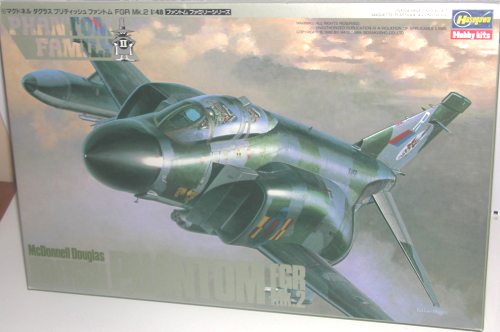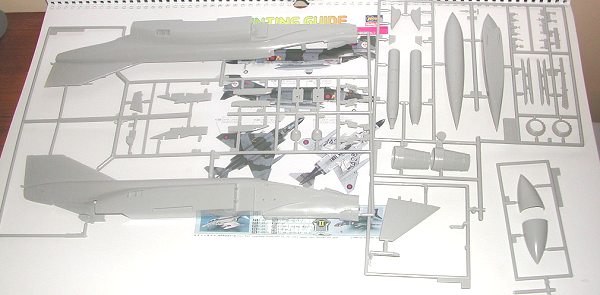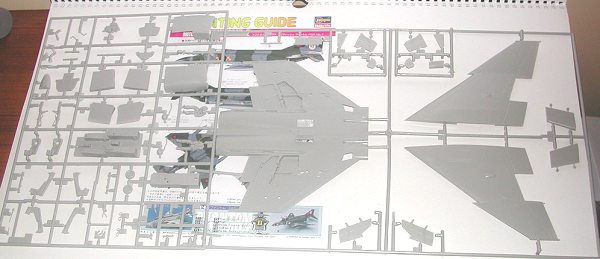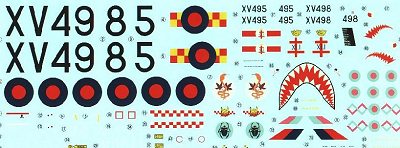
|
KIT: |
Hasegawa 1/48 Phantom FGR.2 |
|
KIT # |
P 16 |
|
PRICE: |
@£26.00 |
|
DECALS: |
Four Aircraft |
|
REVIEWER: |
|
|
NOTES: |

|
HISTORY |
Whereas the Royal Navyís procurement of the Phantom represented the best aircraft to meet the requirement; the Royal Air Force Phantom procurement owed little to military requirements and a great deal to politics.
The 1964 government in the UK for some reason was very hostile to the UK aircraft industry and resented it for absorbing too large a proportion of research funding. At the time the two most important projects the Hawker Siddeley P.1154 (to be replaced by the F-4) and HS.681 (to be replaced by the C-130) were to be cancelled (Amazingly the TSR2 escaped this time). However even the TSR2 (to be replaced by the F-111) was to fall the following year. In one fell swoop the RAF lost its three most crucial projects, condemning it, in its eyes to operate what it saw as inferior and less ambitious equipment.
The US government was prepared to offset the cost of these programmes with orders for the VC-10, however the UK government never pushed the issue and the US let it slide in favor of their own industry.
The UK government did however still push for high UK equipment content for the new Phantoms, however they also specified the Spey engine which the Raf did not want. The RAF wanted the cheaper proven J79.
The production F-4Mís as they were known differed little from the previous RN F-4K aircraft. They did not have the extending nose wheel, instead utilizing a standard F-4C nose oleo. The RAF aircraft was also compatible with both the SUU-16/A and SSU-23/A gun pods.
The RAFís Phantoms entered service in the interdiction/strike role, and were equipped to carry the SNEB rocket pod, 1000lb bomb, and the BL755 cluster bomb. In addition American supplied B28, B43, B57 or B61 nuclear weapons could be carried.
A proportion of RAF aircraft were equipped with dual controls and some were made compatible with a new reconnaissance pod developed by EMI. This contained a roll stabilized Texas Instruments RS-700 infrared linescan unit and a high definition Q-band sideways looking radar, which had mapping and moving target indication capabilities. The pod also contained five optical cameras, with one forward, one vertical and two oblique F.95ís and also a single vertical F.135 whose twin lenses gave a stereo picture. An electronic flash unit could be accommodated in a special under wing tank. The pod could also accommodate and oblique F.95 with a 12inch lens of an F.126 medium-altitude vertical camera.
Carrying the POD did not take away any of the strike role of the aircraft and it was usual for the aircraft to carry bombs/rocket pods at the same time as the POD.
Aircraft normally carried AIM-9 and AIM-7 missiles, however the AIM-7ís were replaced later by the more capable UK developed Sky Flash.
|
THE KIT |

The kit comes on seven grey plastic sprues and one clear one, also included are cast metal front and main wheels with rubber tyres. There is little or no flash present anywhere. Ejection pin marks seem to have been confined to the inside of parts in the whole, there are a couple on some landing gear parts but they are fairly easy to clean away.
On to the kit itself, the Aircraft has raised engraved detail throughout. The cockpit looks to be fairly standard though I must admit I have not checked it for accuracy against reference (though to my knowledge there is no aftermarket cockpit for UK phantoms). The kit features a 5 part ejection seat which while they donít have any kind of belts do come with the top ejection handles which I hate making. I would though suspect that the addition of a couple of aftermarket Martin Bakers would make a great deal of difference (I know I intend to do this). The instrument panels and side consoles all come with raised detail. You will need to paint this as no instruments decals are provided.

Most of the main parts are, as you would expect them. Two fuselage halves with a center split, one-piece bottom center wing and two-piece top wing. There is a small amount of detail moulded into the wheel wells and the landing gear struts are well moulded. The airbrakes can be positioned down if you want to along with the flaps.
Weapons and externals are generally good. Supplied are a centerline large tank with molded pylon, two wing tanks with molded pylons, 4 sparrow missiles, and an SUU-23 centerline gun pod. As usual with Hasegawa kits the instructions invite you to purchase the Weapons sets if you want to add sidewinder missiles. Also included is an EMI centerline reconnaissance pod, for use with the 41 Sqn Aircraft if you chose.
The canopy is in 4 parts and is quite thin; the pieces are well moulded with no seam lines and should present no problems.
Instructions are the usual Hasegawa fold out ones with the main build instructions on one side and painting / decal placement on the reverse.
Decals / Paint Schemes.
For paint schemes the 92 Sqn & 41 Sqn Aircraft use the early Dark Green/Dark Sea Grey camouflage; while the 56 Sqn & 228 OCU aircraft use the standard RAF low vis colours of Light Aircraft Grey / Medium Sea Grey and Barley Grey. As usual with many Hasegawa kits a colour painting guide is supplied of what they consider to be the main scheme, in this kit it refers to option 1 as listed below.
 The decals appear to be the usual Hasegawa offerings. The
white is not white but more an Ivory colour. There are three schemes on offer on
the sheet;
The decals appear to be the usual Hasegawa offerings. The
white is not white but more an Ivory colour. There are three schemes on offer on
the sheet;
In conclusion for the decals, some are usable, but the serious modeler will look for aftermarket replacements. (for this I would recommend ALMARK Decals sheet for the F-4 K/M Raf phantom as it supplies all the correct decals for all 4 schemes featured in this kit.
|
CONCLUSIONS |
This is a very good standard Hasegawa kit, which will build into a good looking model. It is however let down by the ever present (or never present) lack of underwing stores, and by the quality of the decal sheet. Get yourself a couple of aftermarket ejection seats and a good quality decal sheet and this will make a great model.
I would recommend this kit. It looks fairly simple and anyone with even basic skills should be able to make a good job of it.
If you would like your product reviewed fairly and quickly by a site that has well over 175,000 visitors a month, please contact me or see other details in the Note to Contributors.